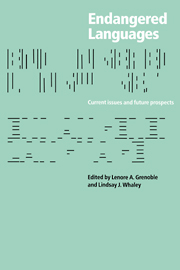Book contents
- Frontmatter
- Contents
- Preface
- List of abbreviations and symbols
- Part I General issues
- Part II Language-community responses
- 3 Technical, emotional, and ideological issues in reversing language shift: examples from Southeast Alaska
- 4 Mayan efforts toward language preservation
- 5 A chronology of Mohawk language instruction at Kahnawà:ke
- 6 Language endangerment in South America: a programmatic approach
- Part III What is lost: language diversity
- Part IV Mechanisms of language loss
- Appendix
- References
- Index of languages
- Index of names
- General index
6 - Language endangerment in South America: a programmatic approach
Published online by Cambridge University Press: 05 June 2012
- Frontmatter
- Contents
- Preface
- List of abbreviations and symbols
- Part I General issues
- Part II Language-community responses
- 3 Technical, emotional, and ideological issues in reversing language shift: examples from Southeast Alaska
- 4 Mayan efforts toward language preservation
- 5 A chronology of Mohawk language instruction at Kahnawà:ke
- 6 Language endangerment in South America: a programmatic approach
- Part III What is lost: language diversity
- Part IV Mechanisms of language loss
- Appendix
- References
- Index of languages
- Index of names
- General index
Summary
Introduction
I will approach the task of talking of language endangerment in the context of South America from two angles. The first one is a geographic and linguistic approach that aims at providing an overview of the situation of the indigenous languages of the region, without encyclopedic ambition but with an eye toward the big picture for those unfamiliar with the specifics of that continent. The second one is a strategic approach that aims at sketching a possible agenda for the linguistic profession in the face of the endangerment situation of South American indigenous languages, taking into account some of the sociopolitical and academic developments of the region in recent times.
The indigenous languages of South America
By South America, I mean the continental part of Latin America south of Panama. For the purpose of this overview I have collated information from some of the most reliable sources on the region, which I have amplified with notes from my recent personal exploration of the situation in countries such as Colombia, Brazil, Ecuador, and Bolivia, and with generous comments from South American specialists.
Adelaar (1991) is the most comprehensive work on the situation of endangerment of the South American indigenous languages. It provides a thorough countrywide treatment based on sources available up to 1988. For the most updated work on the classification, location, and population estimates of the South American languages, the best reference is T. Kaufman (1990, 1994).
- Type
- Chapter
- Information
- Endangered LanguagesLanguage Loss and Community Response, pp. 124 - 160Publisher: Cambridge University PressPrint publication year: 1998
- 20
- Cited by



